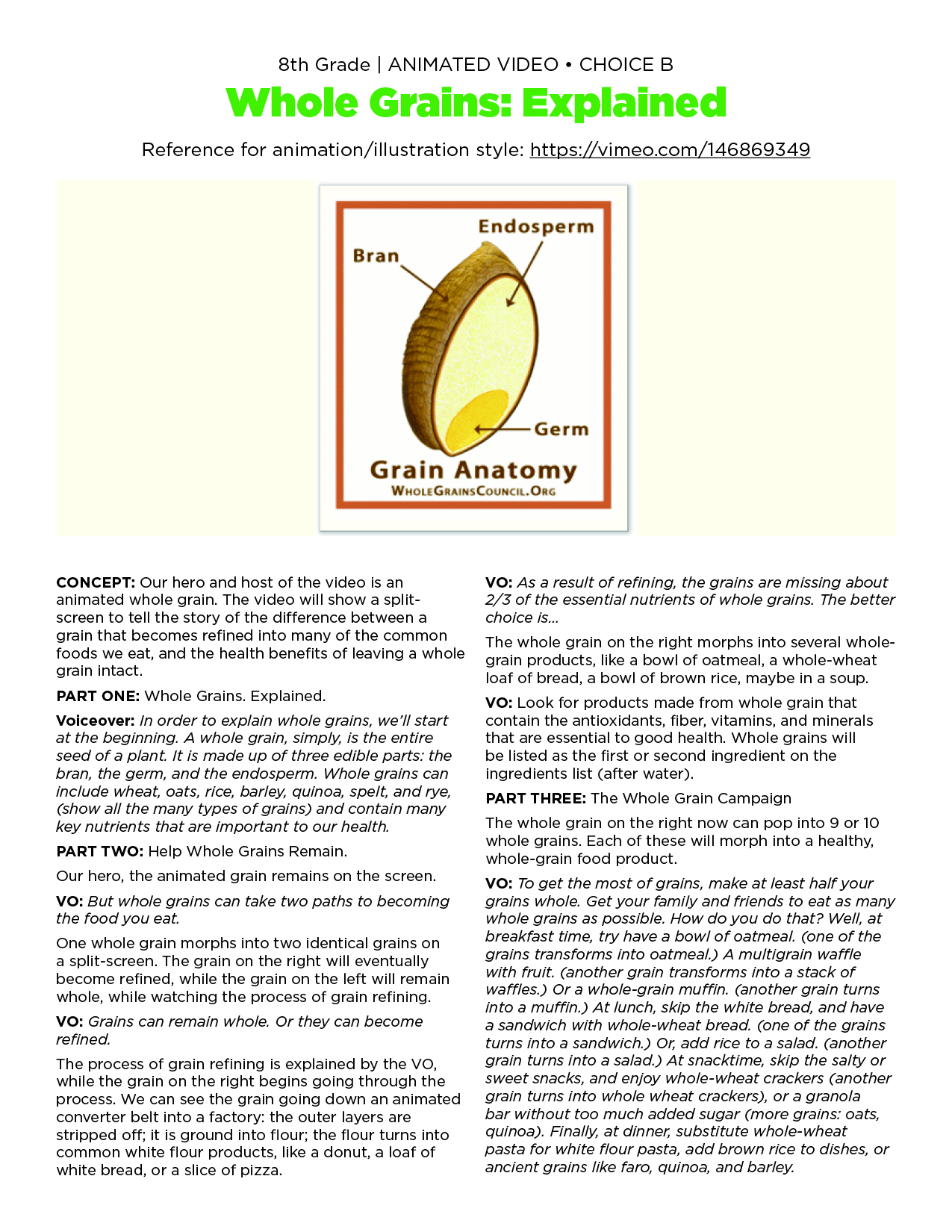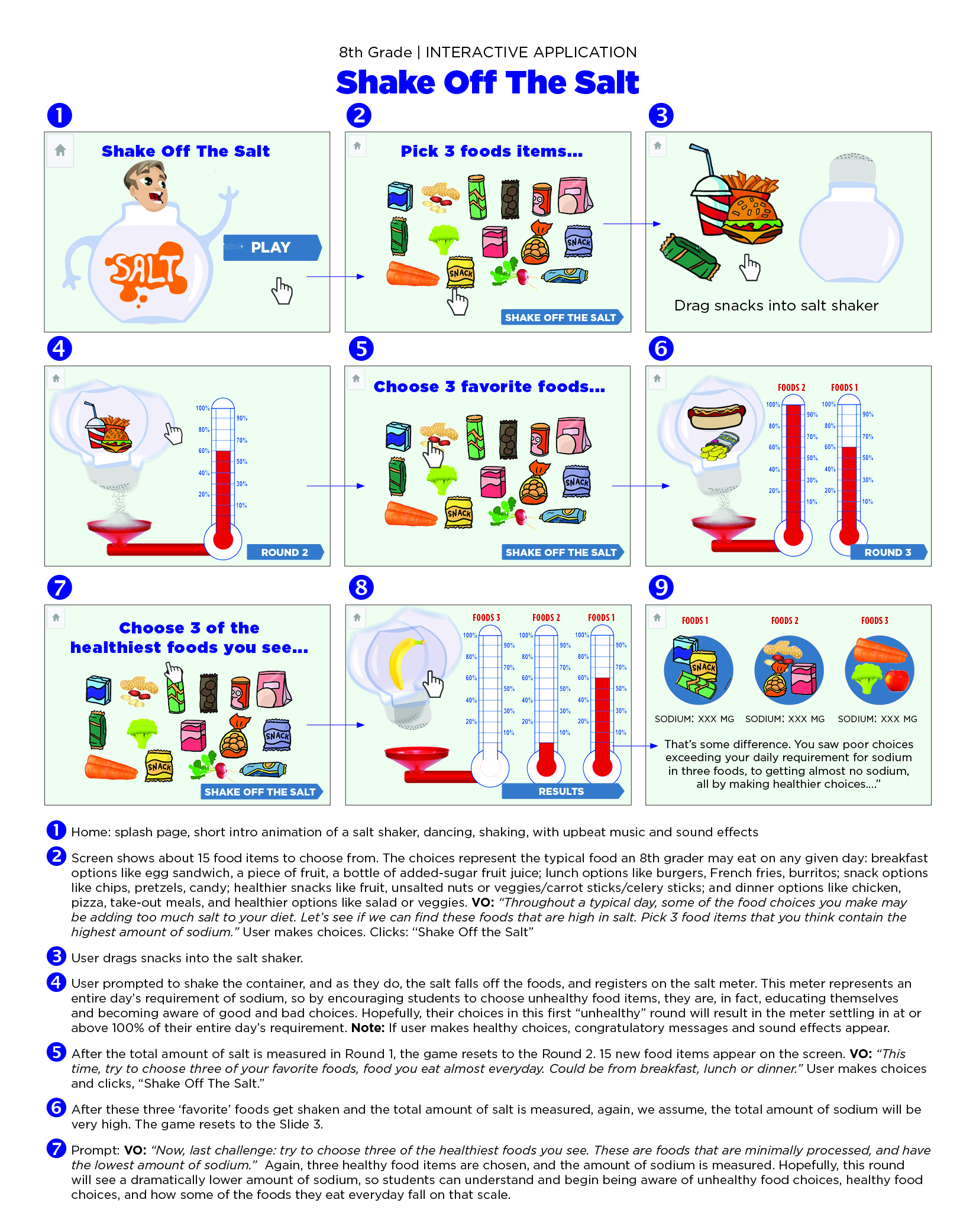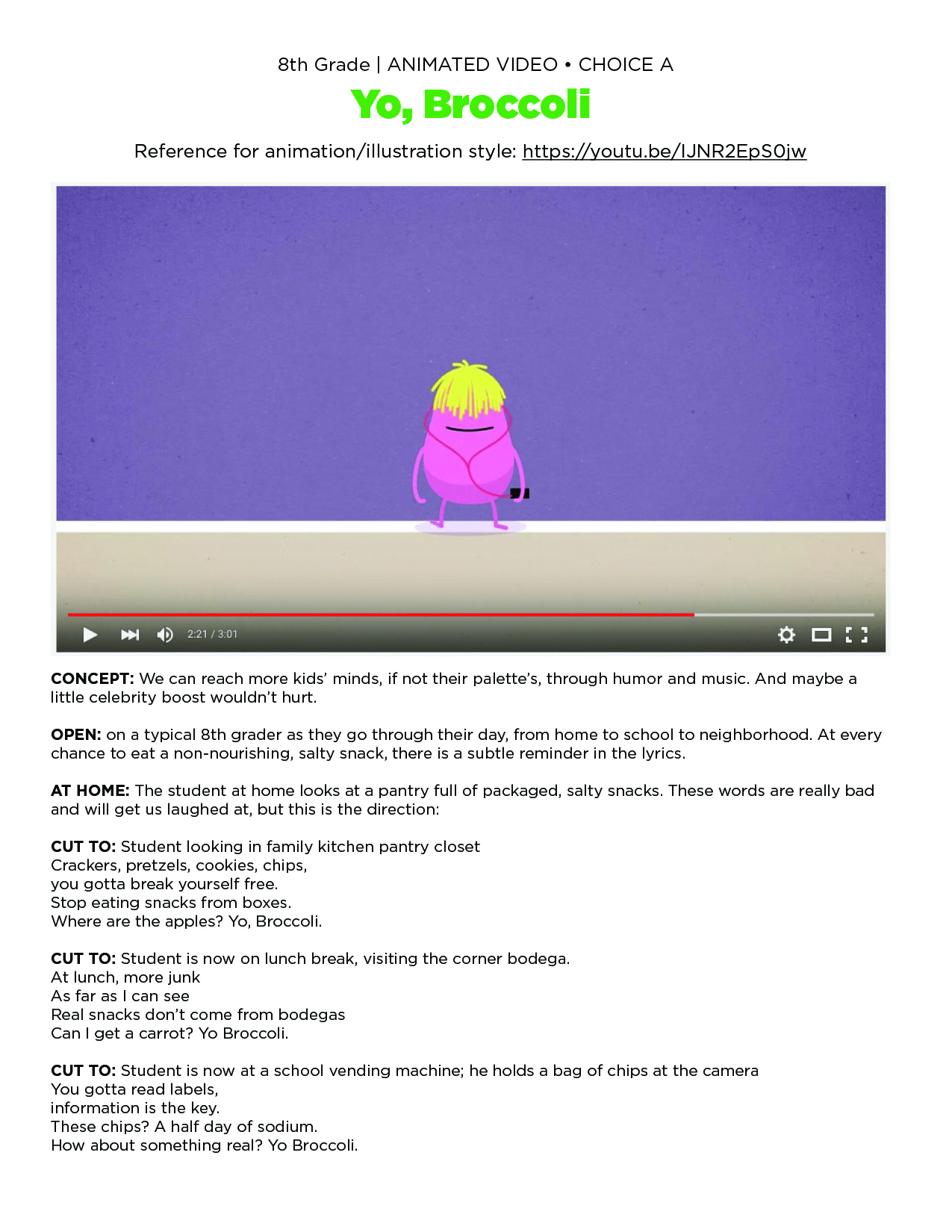Middle School Digital Nutrition I/H
Generic Clearance to Conduct Formative Research
Attachment O_Focus Group Stimulus_Grade 8-rev
Middle School Digital Nutrition I/H
OMB: 0584-0524
OMB Control Number: 0584-0524 | Expires 06/30/2016
Attachment O
OMB BURDEN STATEMENT: According to the Paperwork Reduction Act of 1995, no persons are required to respond to a collection of information unless it displays a valid OMB control number. The valid OMB control number for this information collection is 0584-0524. The time to complete this information collection is estimated at 15 minutes, including the time for reviewing instructions and completing the information collection.
8th GRADE: “The SCIENCE about Food”
Key Message: Drink and eat less sodium in your overall diet, with a goal of less than 2,200 mg per day.
Secondary Message: Make at least half your grains whole grains
8th Grade | INFORMATIONAL TEXT ARTICLES
Whole Grains and Health
Sodium and Your Health
Possible Question Stems
Based on 8th Grade Common Core Standards:
Explicit Information (Reading Literature (RL) 7.8, Reading for Information (RI) 8.1):
Which of the following quotes best describes ______ ?
Which of the following can be reasonably inferred from these two quotes…?
Theme / Idea (RL 8.2, RI 8.2)
Which of the following quotes from the passage is evidence of the central theme?
Word Use (RL 8.4, RI 8.4)
What is the technical meaning of the word _____ ? (i.e. What is the technical meaning of whole grains? What is the technical meaning of sodium?)
Which of the following synonyms is closest to the meaning of the word _____ in line x? (i.e. How does sodium differ from salt?)
Structure (RL 8.5, RI 8.5)
What is the author’s viewpoint on _____ ?
Evaluate how the structure of the text contributes to the development of ideas.
Purpose (RL 8.6, RI 8.6)
How does paragraph (x) support the author’s position?
Based on the author’s information, what is your opinion on...?
Arguments / Claims (RI 8.8)
Which of the following claims are used to support the main argument of this passage...?
Which of the following claims uses valid reasoning…?
Article 1: Whole Grains and Health
This informational text article will explain what whole grains are, why they are an important part of a healthy diet, and how to incorporate them into your meals. The article will connect to the subject area of Science by exploring how grains are refined and how the process affects their nutritional content.
Educational topics covered:
Grains are a group of plants, like wheat, rice, and oats, that produce seeds we can eat.
Grains are ground into flour to make products like breads, rolls, and pizza crust.
Whole grain foods include the whole seed: bran, endosperm, and germ (graphic).
Refined grains separate out the bran and the germ, using just the endosperm.
Whole grains have more fiber, which helps to clean out our intestines.
Dietary fiber, iron, and other nutrients are lost when whole grains are refined and enriched.
For more fiber, choose foods with whole or 100% grain as the first ingredient (after water).
Good fiber sources have 10%-19% of the Daily Value; excellent sources have 20% or more.
Many foods that meet Smart Snack in Schools guidelines are good sources of fiber.
There are lots of tasty ways to enjoy the tasty wholesomeness of whole grains (list).
Make half your grains whole grains. Use the ingredient list to confirm that the main ingredient comes from whole grains.
Subject area tie-in: Science
The science of the grain refinement process
Article 2: Sodium and Your Health
This informational text article will explain what sodium is, where it is found, and how to choose foods with lower sodium levels. The article will connect to the subject area of Science by exploring the nutritional properties of sodium and how sodium affects the human body.
Educational topics covered:
Salt and sodium are not the same thing. Sodium is a mineral, like calcium and potassium. It is found in table salt, but the highest amounts are found in highly processed foods and restaurant foods.
Sodium is an essential nutrient and is needed by the body in relatively small quantities.
The recommended amount is no more than 2,200 milligrams (about 1 tsp.) sodium per day for kids ages 9-13.
The top sources of sodium in kids’ diets are pizza, breads and rolls, cold cuts and cured meats, savory snacks, sandwiches, and cheese.
Most Americans consume too much sodium, an average of 3,500 milligrams per day.
People who consume more sodium tend to have higher blood pressure and could eventually have an increased risk of developing cardiovascular disease.
The best way to reduce sodium intake is to eat more fresh, minimally processed foods, and to avoid eating at restaurants too often.
Reading labels can also help you choose foods with lower sodium levels.
Look for snack foods that have less than 200 milligrams of sodium per serving.
Subject area tie-in: Science
Nutritional properties of sodium
The effects of sodium on our body
8th Grade | LESSON PLANS
Lesson Outline
Transfer Objective
Students will be able to independently use their learning from these activities to:
Decrease overall sodium intake by identifying foods with large amounts of sodium and then finding alternatives.
Learning Objectives
Students will be able to:
Identify high sodium and low sodium food options.
Compare two or three different foods and make a recommendation based on the amount of sodium.
Identify ways in which high sodium intake affects their bodies both in the short term (bloating, dehydration) and in the long term (hypertension, heart disease, and osteoporosis).
Identify “smart snacks” that are low in sodium and higher in whole grains.
Conclude that sodium intake can be lowered by overall diet habits that include cooking at home more often than eating at restaurants, consuming less processed foods, and evaluating food labels.
Enduring Understandings
Evaluating foods and labels before you eat can help you make better choices.
High sodium intake can predispose you to many different health risks.
Processed foods are often higher in sodium than non-processed foods.
Essential Questions
How can I make decisions that keep me healthy?
Why does what we eat matter?
Activities
Read “Sodium and Your Health”and “Whole Grains and Health” informational text article
Answer comprehension questions
Answer class discussion questions
Evaluating amounts of sodium in foods
Teacher will lead presentation and class discussion about sodium’s effects on the body in both the short term and long term. Students will describe symptoms they have encountered when eating salty foods (swelling, dehydration, etc.).
Students will compare nutritional information for the same food item prepared in different ways. Ex. soup from a restaurant, soup from a can, homemade soup. Students will identify the amount of sodium in comparable servings of each and rank them according to the amount of sodium.
Students will identify how to find the nutritional information for foods in restaurants and also at home. They will use this information to find the sodium content of one of their favorite foods. Then they will compare that to the suggested daily intake of sodium and describe it in percentages.
Standards
Sodium and the Human Body
Sodium Intake and Nutrition
Challenge and Investigation (handout to be created)
Students will take an inventory of foods and snacks readily available to them either in school, in the cafeteria or in vending machines, or at nearby convenient stores. Students will choose two food items to evaluate and record sodium and nutrition information. Based on the information they discover, compare, and analyze, they will provide a recommendation for the healthier option. As a class, students will work together to create a chart or poster that ranks all of the foods they researched according to sodium content.
Alternative: Hold a class and/or a school-wide competition! Over the course of a week or a month, use the Groups function in SuperTracker to identify and track the sodium present in the foods everyone eats. Either split into groups in the class, or compete as a class with other classes in the school to see who eats the lowest amount of sodium. How do the daily amounts stack up against the recommended daily amount? Offer prizes for the group or class that wins.
Video Tie-in
The video will help build upon the challenge and the interactive by helping students understand the importance of choosing whole foods that are rich in whole grains.
Interactive Application Tie-in
The interactive application will tie directly into the challenge by helping students to analyze and answer questions about the contents of their food and snacks, including sodium content and serving size.
Note: we do NOT recommend these be the exact words, but a song can be kid-friendly, humorous, and engaging, using the right music production company.


| File Type | application/vnd.openxmlformats-officedocument.wordprocessingml.document |
| Author | Carla Berger |
| File Modified | 0000-00-00 |
| File Created | 2021-01-23 |
© 2025 OMB.report | Privacy Policy
